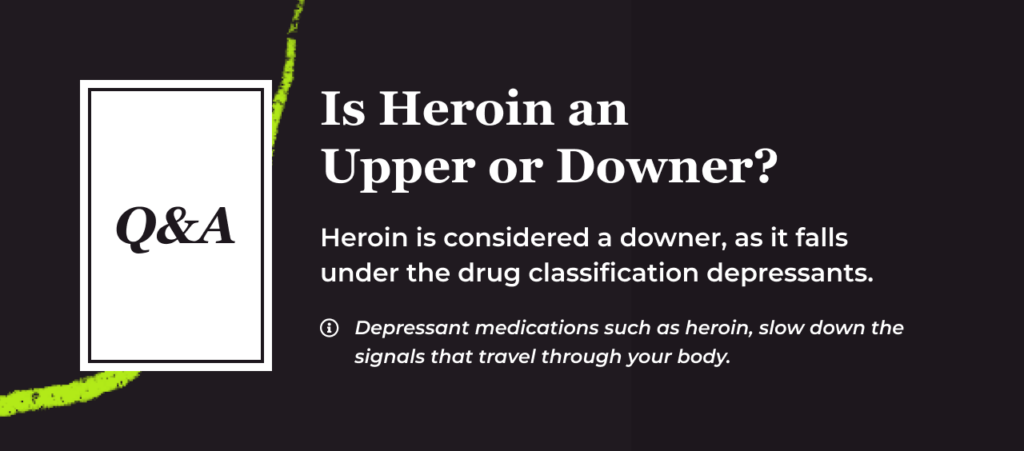Heroin is what people might call a downer, which refers to a type of drug called depressants.

Drugs of this type slow how signals travel through the body. Heroin causes significant reductions in pain as well as a surge of euphoria. Its use also triggers other more dangerous effects, such as respiratory depression and a large burst of dopamine that can make the drug very addictive.
Upper vs. Downer: What’s the Difference?
The term upper usually refers to a stimulant drug, such as cocaine or methamphetamine.[1] Stimulants cause a release of epinephrine, cortisol and other “stimulating” hormones. They tend to make the individual feel energized and powerful.
The term downer usually refers to depressants. A depressant can be thought of as the opposite of a stimulant, slowing down signal activity in the body. These drugs are usually taken to reduce anxiety and tension levels, leading to relaxation and a sense of calm/wellbeing. Common examples are alcohol or benzodiazepines.
Heroin is technically a member of the opioid class, which is its own category. However, clinically it tends to produce effects more similar to “downers”.
What Makes Heroin a Downer or Depressant?
Heroin is technically an opioid, a class of drugs all of its own, separate from true “depressants” like alcohol or benzodiazepines. [2] However, clinically they produce effects similar to “downers”: overall they tend to cause euphoria and relaxation. They tend to make the individual more slow and sedated.
How Does Heroin Work?
Heroin works the same way other opioids work. When it is taken in any form, it attaches itself to opioid receptors in the brain, spinal cord and other organs. [3] When turned on, opioid receptors have a number of effects, including production of dopamine which leads to euphoria and pleasurable sensations, blunting of pain signals, and (concerningly) respiratory depression/sedation.
Why Are Heroin’s Depressant Properties Dangerous?
Heroin, like other depressants, slows breathing by blunting the natural signals that the body sends to breathe automatically. This is one of its most dangerous effects of opioid drugs. In high doses, especially when combined with other drugs that slow breathing, heroin can cause a life-threatening level of respiratory depression.[4] The muscles needed to breathe become so weak that a person stops breathing, leading to death.
If an overdose occurs, it is a medical emergency. Call 911 immediately. If available, the drug naloxone should be administered to the individual. Even if naloxone is administered and the person recovers, further professional medical care is still needed, as the overdose can return once naloxone wears off.[5] Patients should be monitored for several hours after receiving Naloxone to make sure they do not overdose again.
Heroin & Clinical Depression
Depression (and other mental health disorders) are more common in people taking opioids, including people taking prescription opioids on a long-term basis for chronic pain. [6]
Common signs of depression include the following:[7]
- Feeling sad, anxious or like emotions are dulled
- Feeling hopeless or pessimistic
- Feeling irritable, frustrated or restless
- Feeling guilty, helpless or like you aren’t valuable
- Feeling aches, pains or having similar health issues with no clear physical cause
- Trouble concentrating or with decision-making
- Memory problems
- Sleep issues, including trouble getting to sleep as well as trouble with oversleeping
- A reduced or inability to feel joy or interested in things you once found fun
- Significant changes in appetite and/or weight
- Thoughts of suicide or attempting suicide
If you have any thoughts of self-harm, seek help immediately. With the right help on all fronts, you can receive treatment for depression as well as substance use disorder. Reach out to Bicycle health today to learn more.

Medically Reviewed By Elena Hill, MD, MPH
Elena Hill, MD; MPH received her MD and Masters of Public Health degrees at Tufts Medical School and completed her family medicine residency at Boston Medical Center. She is currently an attending physician at Bronxcare Health Systems in the Bronx, NY where ... Read More
- Motivations for Concurrent Use of Uppers and Downers Among People Who Access Harm Reduction Services in British Columbia, Canada: Findings From the 2019 Harm Reduction Client Survey. BMJ Open. https://www.ncbi.nlm.nih.gov/pmc/articles/PMC9062822/. May 2022. Accessed March 2023.
- The Neurobiology of Opioid Dependence: Implications for Treatment. Addiction Science & Clinical Practice. https://www.ncbi.nlm.nih.gov/pmc/articles/PMC2851054/. July 2002. Accessed March 2023.
- Prescription Opioids. National Institute on Drug Abuse. https://nida.nih.gov/publications/drugfacts/prescription-opioids. June 2021. Accessed March 2023.
- Understanding Heroin Overdose: A Study of the Acute Respiratory Depressant Effects of Injected Pharmaceutical Heroin. PLOS ONE. https://www.ncbi.nlm.nih.gov/pmc/articles/PMC4619694/. October 2015. Accessed March 2023.
- SAMHSA Opioid Overdose Prevention Toolkit. Substance Abuse and Mental Health Services Administration. https://store.samhsa.gov/sites/default/files/d7/priv/sma18-4742.pdf. 2014. Accessed March 2023.
- Frequency of Use Increases Risk for Depression Among Long-Term Prescription Opioid Users. Saint Louis University. https://www.slu.edu/news/2022/january/depression-risk-opioid-users.php. Accessed March 2023.
- Depression. National Institute of Mental Health. https://www.nimh.nih.gov/health/topics/depression. September 2022. Accessed March 2023.
Download Our Free Program Guide
Learn about our program, its effectiveness and what to expect
Related Content
Imagine what’s possible on the other side of opioid use disorder.
Our science-backed approach boasts 95% of patients reporting no withdrawal symptoms at 7 days. We can help you achieve easier days and a happier future.